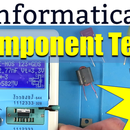Introduction: Make a Novelty Spanish Bull Clock
I recently bought a CNC router and this is one of the first
things I made. I will show you how to make one too.
Old LP records make an ideal source of vinyl which can be easily cut to your desired shape.
In my case I wanted to make a clock similar to that shown in the UK comedy series “Benidorm”, the clock can be seen in episodes in the pool bar.
The iconic image of the Bull is based on the famous Spanish landmark of the Osbourne Bull created in 1956 by the artist Manolo Prieto. The, um, “pendulum” is not to scale!
The video shows the build and the following steps explain the process.
Step 1: Grab an Old LP
Choose your LP and measure the thickness with a digital
caliper so you can set the depth of cut for the router bit. I have since added a Z axis probe which removes the need of this step.
The image of the Bull was converted from a JPG to DXF by using the Inkscape program. I show how to do this in another video https://www.youtube.com/watch?v=XjSDippnGoM
The resulting DXF is used to generate GCODE that controls the CNC router. This GCODE needs to be edited for the depth of cut you need for your LP. Again this step is unnecessary if you have a Z axis probe.
Step 2: CNC Router Setup
My CNC machine came with a program called CNC USB Controller
so I load the GCODE into it. Your CNC machine may have different software but the process is the same.
The LP is stuck down onto the base board using double sided sticky tape.
The cutter I am using is a 3.175mm Shank 1.5 x 6mm Tungsten Steel Parallel Milling Cutter.
Now it is time to set the X and Y axis zero point. I do this by looking at the GCODE to determine approximately where the Bull will be on the LP and measuring from there. It requires a degree of experimentation but we will be doing a test pass before cutting to ensure that the extremes of the Bull i.e. the horns and tail are within the area of the LP.
Before starting the test cut make sure you have set the zero X and Y axis. To perform the test cut position the cutter well above the LP surface and run the code, the spindle does not need to be running for this.
Step 3: Prepare to Cut!
Now we can prepare for the actual cut. Use the jog function
on your CNC to position the cutter over the LP surface. Turn off the CNC so you can move the Z axis by hand. Make sure you do not move either the X or Y axis while you do this. I use an old feeler gauge to feel when the cutter is just above the surface.
Now you can turn the CNC machine back on and zero the X and Y axis. All is prepared now for the final cut so at this point PUT ON YOUR SAFETY GLASSES!
Switch on the spindle motor and set to your desired cutting speed, maximum works for me!!
Step 4: Assembly
Now you can power off the CNC and release the LP from the
cutting board. Separate the body and pendulum. Normally the cut should be quite clean. You can use a file or sandpaper if you find some rough spots.
I use a pendulum clock movement which is widely available but usually you have to order the hands separately. I choose not to use the supplied hanging fixture as it protrudes above the Bull’s back. Instead I print my own on a 3D printer.
Mark out where to drill the hole for the movement on the back of the Bull. This will be around 43 mm from the top of the Bull’s back. With a centre line in the middle of the castrated section! I find using a stepped drill bit makes this a simple task.
Next attach the pendulum “bob” with hot melt glue.
Depending on the clock movement you get you may need a spacer to get the correct level for the hands on the clock face. I simply cut a small length of irrigation pipe for this. Now you can mount the movement using the supplied washer and nut.
Either attach the supplied clock hanger or hot melt glue your own hanger to the back.
The hands are simply pushed on to their respective spindles. Take care not to bend them as they are very fragile. Check to see that they are all parallel to the clock face and will not touch each other.
Now you can fit the battery and admire your work! It is best to use a quality alkaline cell for this project.

Participated in the
Clocks Contest











